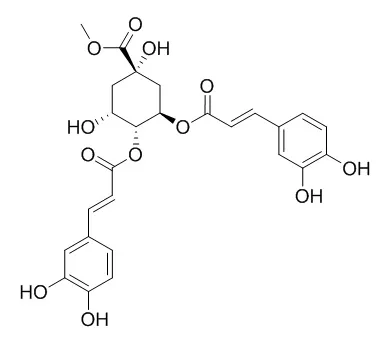| In vitro: |
| J Agric Food Chem. 2014 Aug 27;62(34):8608-15. | | Functional analyses on antioxidant, anti-inflammatory, and antiproliferative effects of extracts and compounds from Ilex latifolia Thunb., a Chinese bitter tea.[Pubmed: 25118953 ] | Ilex latifolia Thunb., widely distributed in China, has been used as a functional food and drunk for a long time.
METHODS AND RESULTS:
This study was aimed to identify the bioactive constituents with antioxidant, antitumor, and anti-inflammatory properties. I. latifolia was extracted with 95% ethanol and then partitioned into four fractions: petroleum ether fraction, ethyl acetate fraction, n-butanol fraction, and water fraction. Results showed that the ethyl acetate fraction was found to have significant ferric reducing antioxidant power activity, DPPH radical scavenging activity, and oxygen radical absorbance capacity, cytotoxicity against human cervix carcinoma HeLa cells, and inhibitory effect on NO production in macrophage RAW 264.7 cells. Five compounds were isolated from the ethyl acetate fraction, and they were identified as ethyl caffeate (1), ursolic acid (2), chlorogenic acid (3), 3,4-Di-O-caffeoylquinic acid methyl ester (4), and 3,5-di-O-caffeoylquinic acid methyl ester (5), the last two of which were isolated for the first time from I. latifolia. Compounds 4 and 5 exhibited cytotoxicity actions against tumor cell line. Compound 3 showed the strongest anti-inflammatory activity of all the compounds.
CONCLUSIONS:
The results obtained in this work might contribute to the understanding of biological activities of I. latifolia and further investigation on its potential application values for food and drug. | | Chinese Traditional & Herbal Drugs, 2015 , 46 (11) :1597-602. | | Study on chemical constituents from Re-Du-Ning Injection (II)[Reference: WebLink] | To investigate the chemical constituents from Re-Du-Ning Injection (RDN).
METHODS AND RESULTS:
The chemical constituents were isolated by chromatography on silica gel, ODS, Sephadex LH-20, and Toyopearl HW-40 columns and reverse phase MPLC and HPLC repeatedly. Their structures were identified by spectral data and physicochemical property. Sixteen compounds were isolated and identified as 5-O-caffeoylquinic acid (1), 5-O-caffeoylquinic acid methyl ester (2), 4-O-caffeoylquinic acid (3), 5-O-caffeoylquinic acid methyl ester (4), 4,5-di-O-caffeoylquinic acid (5), 4,5-di-O-caffeoylquinic acid methyl ester (6), 3,5- di-O-caffeoylquinic acid (7), 3,5-di-O-caffeoylquinic acid methyl ester (8), 3,4-di-O-caffeoylquinic acid (9), 3,4-Di-O-caffeoylquinic acid methyl ester (10), secologanic acid (11), vogeloside (12), 7-epi-vogeloside (13), E-aldosecologanin (14), Z-aldosecologanin (15), and 5H,8H-pyrano[4,3-d] thiazolo[3,2-a] pyridine-3-carboxylic acid (16). Compounds 1-10 showed high efficiency and low toxicity with antivirus activity against RSV.
CONCLUSIONS:
All the isolated compounds are reported from RDN Injection for the first time, and caffeoylquinic acids may be one of antivirus pharmacodynamic material bases of RDN. |
|






 Cell. 2018 Jan 11;172(1-2):249-261.e12. doi: 10.1016/j.cell.2017.12.019.IF=36.216(2019)
Cell. 2018 Jan 11;172(1-2):249-261.e12. doi: 10.1016/j.cell.2017.12.019.IF=36.216(2019) Cell Metab. 2020 Mar 3;31(3):534-548.e5. doi: 10.1016/j.cmet.2020.01.002.IF=22.415(2019)
Cell Metab. 2020 Mar 3;31(3):534-548.e5. doi: 10.1016/j.cmet.2020.01.002.IF=22.415(2019) Mol Cell. 2017 Nov 16;68(4):673-685.e6. doi: 10.1016/j.molcel.2017.10.022.IF=14.548(2019)
Mol Cell. 2017 Nov 16;68(4):673-685.e6. doi: 10.1016/j.molcel.2017.10.022.IF=14.548(2019)